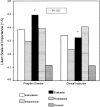Program Directors' and Clinical Instructors' Perceptions of Important Clinical-Instructor Behavior Categories in the Delivery of Athletic Training Clinical Instruction
- PMID: 14737217
- PMCID: PMC314394
Program Directors' and Clinical Instructors' Perceptions of Important Clinical-Instructor Behavior Categories in the Delivery of Athletic Training Clinical Instruction
Abstract
OBJECTIVE: To investigate the perceived importance of clinical instructors' behaviors and behavior categories in the roles of program director (PD) and clinical instructor (CI) and to ascertain the relative importance of these items within each role. DESIGN AND SETTING: From the literature, we developed a questionnaire, validated by a panel of experts, to collect data regarding the perceived importance of 30 specific CI behavior statements within 5 categories (instructional, interpersonal, evaluative, professional, and personal). The instrument used in the study had a Cronbach alpha of.92. SUBJECTS: Independent groups of 75 PDs and 242 CIs from Commission on Accreditation of Allied Health Education Programs-accredited entry-level undergraduate athletic training programs returned usable surveys. MEASUREMENTS: We computed mean and variation measures for each behavior and category and analyzed these items for between-role and within-role category differences. RESULTS: Program directors and CIs differed significantly in the perceived importance of the evaluative category of CI behaviors as well as in 3 specific evaluative behaviors. Program directors and CIs did not differ in the other 4 categories. For within-role groupings, we noted significant differences of perceived importance among the behavioral categories. CONCLUSIONS: Program directors and CIs perceived all 5 categories to be very important, and they should work to demonstrate these behaviors in clinical-education settings. Collaboration between the groups enhances the understanding of role responsibility in the delivery of athletic training clinical instruction.
Figures



References
-
- McCabe BW. The improvement of instruction in the clinical area: a challenge waiting to be met. J Nurs Educ. 1985;24:255–257. - PubMed
-
- Gaberson KB, Oermann MH. Clinical Teaching in Nursing. New York, NY: Springer Publishing Company; 1999. pp. 12–21.pp. 57–75.
-
- Jarski RW, Kulig K, Olson RE. Clinical teaching in physical therapy: student and teacher perceptions. Phys Ther. 1990;70:173–178. - PubMed
-
- Reilly DE, Oermann MH. Clinical Teaching in Nursing Education. 2nd ed. New York, NY: National League for Nursing; 1992. pp. 109–117.pp. 151–155.
-
- Meleca CB, Schimpfhauser F, Witteman JK. Clinical instruction in nursing: a national study. J Nurs Educ. 1984;20:32–40. - PubMed
LinkOut - more resources
Full Text Sources
Miscellaneous
